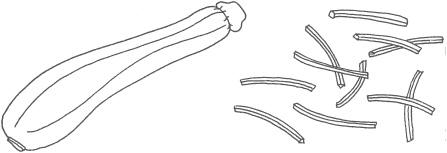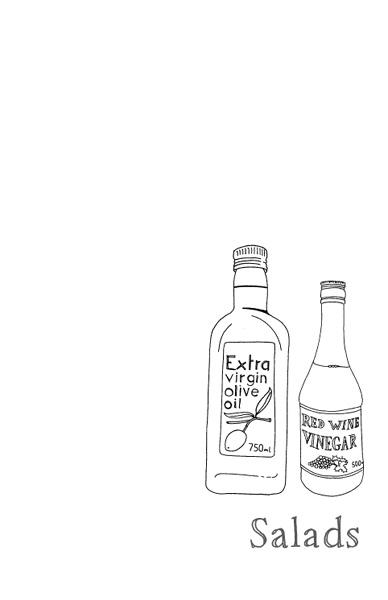The Thrifty Cookbook: 476 Ways to Eat Well With Leftovers (62 page)
Read The Thrifty Cookbook: 476 Ways to Eat Well With Leftovers Online
Authors: Kate Colquhoun
Tags: #General, #Cooking

BOOK: The Thrifty Cookbook: 476 Ways to Eat Well With Leftovers
10.55Mb size Format: txt, pdf, ePub
The perfect partner for soufflé is a simple crispy green salad, just lightly dressed – there’s something intrinsically ‘right’ about this combination of colours, textures and tastes.
The simplest of all soufflés and a brilliant way of using up the ends of hard cheese like Cheddar or Parmesan.
Serves 2–3
25g butter
25g plain flour
150ml milk
75g strong hard cheese, finely grated
3 large eggs, separated
salt and pepper
Preheat the oven to 200°C/Gas Mark 6. Butter a 900ml soufflé dish (about 20cm in diameter).
Now make a white sauce: melt the butter in a small pan, add the flour and stir well over a low heat for a minute. Gradually add the milk, whisking as you go to prevent any lumps forming. Bring to a bare simmer and allow the sauce to thicken for 2–3 minutes. Remove from the heat, stir in the cheese, then season and pour into a good-sized bowl (to give you space to add the egg whites later). Leave to cool for 5 minutes or so, then stir in the egg yolks.
In a separate bowl, whisk the egg whites until they form firm peaks. Gently stir a spoonful of the whisked whites into the cheese sauce to loosen it and then softly fold in the rest. Pour the mixture cleanly into the soufflé dish and put on to the centre shelf of the oven. Bake – without opening the door to take a peek – for 25–30 minutes. The soufflé should be well risen. A skewer or a strand of spaghetti pushed quickly into the centre will confirm that it is cooked right through if it comes out without any runny mixture sticking to it (though the soufflé should be slightly wobbly, and definitely not solid). Serve immediately, with a tart leaf salad and a sprinkling of grated Cheddar or Parmesan.
Broccoli, leek, spinach or rocket
Add a teacup of finely chopped cooked vegetables or uncooked rocket to the base mixture before folding in the whites. I always add an extra egg white to help hold the whole thing up (whisk it up with the rest). You could use Stilton here instead of other hard cheese.
Butternut squash or sweet potato
Use a teacup of cooked vegetables cut into very small dice and a sprinkling of fresh thyme, adding them to the base mixture. Substitute goat’s cheese for hard cheese, if you like, and add an extra egg white to the beaten whites.
Courgette
Add to the base mixture a good teacupful of cooked grated courgettes, squeezed fairly dry, and season with lots of freshly ground black pepper. Add an extra egg white to the beaten whites.

A litre of surplus milk is all you need for around 225g cottage cheese or a little less paneer, and both are as straightforward to make as yogurt. Cottage cheese is delicious in salads or savoury pancake fillings, while paneer can be eaten on its own or take the place of meat in Indian curries with tomatoes, spinach peas or almost any other vegetable. Both will keep in the fridge for up to a week in an airtight box (as with mozzarella, including a little of the watery whey will help to keep the cheeses fresh).
I think full-fat milk is best here but skimmed will work too.
Bring 1 litre of milk to the boil in a large pan. Turn off the heat, add a tablespoon of lemon juice and a pinch of salt and stir well. After about 5 minutes the curds and whey (or watery fluid) will start to separate. When they are completely separate, strain the whole lot through a fine sieve or muslin bag and, while it is still in the sieve or bag, gently rinse the lumpy white curds under the tap to cool them down.
Push down on the curds in the sieve to squeeze out as much whey as possible. What’s left is the best kind of cottage cheese.
The Indian way with cottage cheese is to squeeze and press it quite hard until it forms a sliceable soft cheese. It is one of the great delights of Indian cooking, a sublimely gentle partner for vegetables in a subtle curry or eaten on its own with figs or dates, with a plate of fresh herbs or with a dollop of runny honey and some fresh walnuts or toasted nuts.
Make cottage cheese as above, then put the curds into a clean tea towel or a piece of muslin. Twist the cloth to wring out as much liquid as possible. You could also tie the ends together and leave the cheese suspended over a bowl to drip for a few hours. Put the cloth and curds on a plate, then put a heavy weight on top – a big can of tomatoes or a saucepan filled with water will do – slightly slanting the plate in the sink or another large bowl so that the last drops of whey can run off. After about 5 hours, the cheese will be done.

We tend to think of salads as using lots of the freshest ingredients, so they often get forgotten when it comes to leftovers. But salads are more than just about summer and dietary worthiness – with a handful of good fresh herbs or some toasted nuts or seeds, a simple plate of leaves with leftover meat, fish or vegetables is less an apologetic side dish than a meal in itself.
Other books
Heris Serrano by Elizabeth Moon
BAD TRIP SOUTH by Mosiman, Billie Sue
Apron Anxiety by Alyssa Shelasky
Chance Encounter by Alesso, Chris
Christmas in Camelot by Mary Pope Osborne
Doctor Who BBCN17 - Sick Building by Doctor Who
The Dark Assassin by Anne Perry
Fear in the Forest by Bernard Knight
The Lost Treasure of Tuckernuck by Emily Fairlie
The Heart of a Duke by Victoria Morgan




